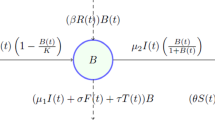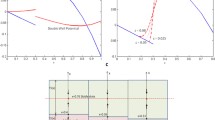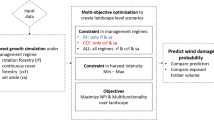Abstract
To contribute to the fight against forest fires, which cause enormous damage every year, we propose in this paper a model of the movements of dry grass in a forest, since the occurrence and magnitude of the fire in an area are proportional to the amount of grass in it. Inspired by the works of Rachik et al. [(Soukaina et al. in Math Biol Neurosci 2020, 2020), (Zakary et al. in Int J Dyn Control 1–14, 2016a, Adv Differ Equ 2016:169, 2016b)]. We subdividing the total area under consideration into an appropriate number of hexagonal patches, we propose a discrete spatiotemporal mathematical model, taking into account the intensity and direction of the wind vector, to describe the transfer of dry grasses from one patch to neighbouring patches. After stating that a patch is at high risk if the amount of grass found exceeds a predefined tolerance threshold, we adopt the control variable “gathering of grass” to minimize the risk of a possible fire. To illustrate the theoretical results obtained, we propose numerical simulations for several scenarios applying the forward-backwards sweep method (FBSM) to solve our optimality system in an iterative process.





Similar content being viewed by others
Data availability
The disciplinary data used to support the findings of this study have been deposited in the Network Repository (http://www.networkrepository.com).
Code availability
The computer code used in this study is available.
References
Alexander D (2018) Natural Disasters. Routledge
Ben Rhila S, Ghazzali R, El Bhih A et al (2020) Optimal control problem of a quarantine model in multi region with spatial dynamics. Commun Math Biol Neurosci 2020
Bensaude-Vincent B, Stengers I (1996) A history of chemistry. Harvard University Press
Boyer Carl B, Merzbach Uta C (2011) A history of mathematics. John Wiley & Sons
Campbell-Kelly M, Aspray W, Ensmenger N, Yost JR (2018) Computer. Routledge
Carroll Bradley W, Ostlie Dale A (2017) An introduction to modern astrophysics. Cambridge University Press
Castiglioni A (2019) A history of medicine. Routledge
Choi D, Shin H, Kim K (2023) CEOs childhood experience of natural disaster and CSR activities. J Bus Ethics. https://doi.org/10.1007/s10551-022-05319-3
Collett JP (2003) The history of electronics: from vacuum tubes to transistors. In: Krige J, Pestre D (eds) Companion to Science in the Twentieth Century. Routledge, London/New York, NY, pp 253–274
Dabbs K (2010) Optimal control in discrete pest control models. Thesis. trace.tennessee.edu
Degg M (1992) Natural disasters: recent trends and future prospects. Geography 77(3):198–209
Fischer T, Herr CM (2019) An Introduction to design cybernetics. In: Fischer T, Herr C (eds) Design cybernetics. Design research foundations. Springer, Cham. https://doi.org/10.1007/978-3-030-18557-2_1
Gauthier J, Vincent AT, Charette SJ, Derome N (2018) A brief history of bioinformatics. Brief Bioinform 20(6):1981–1996
Green JD, Burge J, Stansberry JA, Meinke B (2016) Cameras a million miles apart: stereoscopic imaging potential with the Hubble and james webb space telescopes. ar**v preprint ar**v:1610.07483
Hopwood N, Cohen J (2008) Greenhouse gases and society. Retriev April 8:2008
Hulla JE, Sahu SC, Hayes AW (2015) Nanotechnology. Hum Exp Toxicol 34(12):1318–1321
Isern J, Bravo E (2018) White dwarf collisions, a promising scenario to account for meteoritic anomalies. ar**v preprint ar**v:1809.01825
Kanamori H, Brodsky EE (2004) The physics of earthquakes. Rep Prog Phys 67(8):1429
Khalifa MM et al (2023) Evaluation of the subsurface structural features of the Farafra Oasis, western desert, Egypt using aeromagnetic data. Model Earth Syst Environ. https://doi.org/10.1007/s40808-023-01806-2
Kleppner D, Kolenkow R (2014) An introduction to mechanics. Cambridge University Press
Laframboise N, Loko B (2012) Natural disasters: mitigating impact, managing risks. International Monetary Fund. https://doi.org/10.5089/9781475512717.001
Mahalle PN, Ambritta PN, Sakhare SR, Kulkarni AP (2023) Interdisciplinary engineering problems. In: Foundations of mathematical modelling for engineering problem solving. Springer, pp 157–166
McAsey M, Mou L, Han W (2012) Convergence of the forward-backward sweep method in optimal control. Comput Optim Appl 53:207–226
Messiah A (2014) Quantum mechanics. Courier Corporation
National Research Council et al (1991) A safer future Reducing the impacts of natural disasters. National Academies Press
Pollinger F et al (2023) The European GeoMetre project: develo** enhanced large-scale dimensional metrology for geodesy. Appl Geomat. https://doi.org/10.1007/s12518-022-00487-3
Pontryagin LS, Boltyanskii VG, Gamkrelidze RV et al (1962) The mathematical theory of optimal processes, international series of monographs in pure and applied mathematics. Interscience, New York
Read HH, Watson J (1975) Introduction to geology. Macmillan International Higher Education, Cham
Robock A (2000) Volcanic eruptions and climate. Rev Geophys 38(2):191–219
Rothman Kenneth J (2012) Epidemiology: an introduction. Oxford University Press
Roy C et al (2023) Tropical cyclone intensity forecasting in the Bay of Bengal using a biologically inspired computational model. Model Earth Syst Environ. https://doi.org/10.1007/s40808-023-01786-3
Sales VG, Strobl E (2023) Using extreme value theory to assess the mortality risk of tornado outbreaks. Int J Dis Risk Sci 14(1):14–25
Sapir DG, Lechat MF (1986) Reducing the impact of natural disasters: why aren’t we better prepared? Health Policy and Plan 1(2):118–126
Satake K et al (2020) History and features of trans-oceanic tsunamis and implications for paleo-tsunami studies. Earth Sci Rev 202:103112
Shearer Peter M (2019) Introduction to seismology. Cambridge University Press
Sherwood Rowland F (2006) Stratospheric ozone depletion. Philos Trans R Soc B Biol Sci 361(1469):769–790
Solomatine DP, Siek MB (2006) Modular learning models in forecasting natural phenomena. Neural Netw 19(2):215–224 (Earth Sciences and Environmental Applications of Computational Intelligence)
University of Arizona (2017) Winds. Atmospheric Sciences 336 - Spring 2017. http://www.atmo.arizona.edu/students/courselinks/spring17/atmo336s2/lectures/sec1/winds.html
Van Aalst Maarten K (2006) The impacts of climate change on the risk of natural disasters. Disasters 30(1):5–18
Wandi D, Hendon R, Cathey B, Lancaster E, Germick R (2014) Discrete time optimal control applied to pest control problems. Involv J Math 7(4):479–489
Zakary O, Larrache A, Rachik M, Elmouki I (2016) Effect of awareness programs and travel-blocking operations in the control of HIV/AIDS outbreaks: a multi-domains SIR model. Adv Differ Equ 2016:169
Zakary O, Rachik M, Elmouki I (2017) On the analysis of a multi-regions discrete SIR epidemic model: an optimal control approach. Int J Dyn Control. https://doi.org/10.1007/s40435-016-0233-2
Funding
Not applicable.
Author information
Authors and Affiliations
Contributions
All authors have contributed equally to this study.
Corresponding author
Ethics declarations
Conflict of interest
Not applicable.
Ethics approval
Not applicable.
Consent to participate
Not applicable, as the study does not involve human participants.
Consent for publication
Not applicable, as the article does not contain any personal information.
Additional information
Publisher's Note
Springer Nature remains neutral with regard to jurisdictional claims in published maps and institutional affiliations.
Rights and permissions
Springer Nature or its licensor (e.g. a society or other partner) holds exclusive rights to this article under a publishing agreement with the author(s) or other rightsholder(s); author self-archiving of the accepted manuscript version of this article is solely governed by the terms of such publishing agreement and applicable law.
About this article
Cite this article
Amine, G., Marouane, L., Soukaina, B.R. et al. On the mathematical modelling and control of leaf movements. Model. Earth Syst. Environ. 10, 1109–1116 (2024). https://doi.org/10.1007/s40808-023-01825-z
Received:
Accepted:
Published:
Issue Date:
DOI: https://doi.org/10.1007/s40808-023-01825-z




